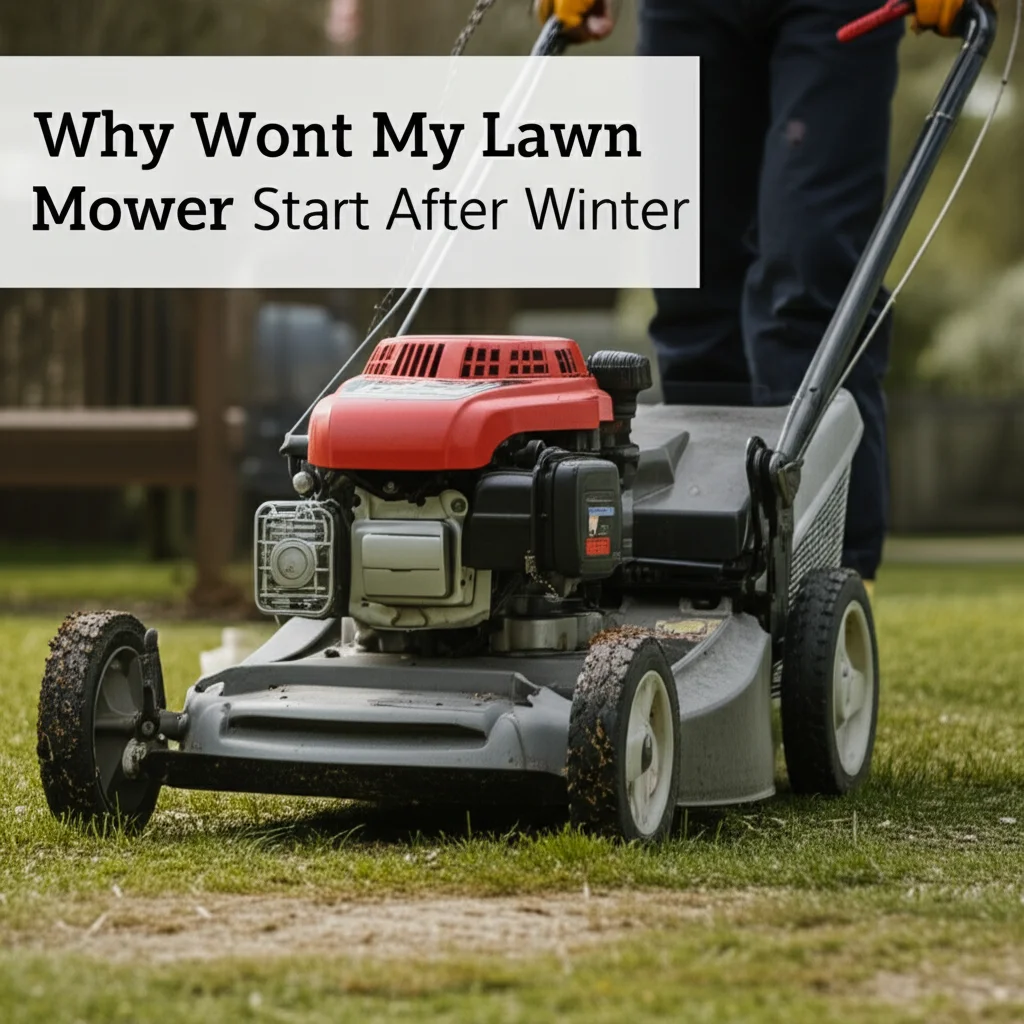· Lawn Care · 9 min read
Why Is My Self Propelled Mower So Hard To Push

Why Is My Self Propelled Mower So Hard To Push? Solutions Inside
Nothing’s more frustrating than fighting with a self-propelled mower that feels like you’re pushing a boulder uphill.
If your self-propelled lawn mower is so hard to push that you’re breaking a sweat before you’ve even started cutting grass, you’re not alone.
This common problem affects thousands of homeowners, but the good news is that most causes are fixable with some basic troubleshooting.
Key Takeaways
• Drive system issues are the most common cause of hard-to-push self-propelled mowers
• Wheel and tire problems can create significant resistance when pushing
• Engine and blade complications add unnecessary weight and drag
• Simple maintenance can resolve 80% of pushing difficulties
• Professional help may be needed for transmission or drive belt problems
Quick Answer: Your self-propelled mower is hard to push because the drive system isn’t disengaging properly, wheels are damaged or misaligned, the engine isn’t running efficiently, or debris is blocking moving parts. Most issues stem from worn drive belts, damaged wheels, or improper maintenance.
Understanding Self-Propelled Mower Mechanics
Self-propelled mowers work by transferring power from the engine to the wheels through a drive system. When functioning correctly, the mower should move forward with minimal effort when the drive control is engaged, and roll freely when disengaged.
The drive mechanism typically includes a drive belt, transmission, and wheel assemblies. When you release the drive control handle, the system should disengage completely, allowing the mower to roll as easily as a standard push mower. If any component in this system malfunctions, you’ll experience increased resistance.
Most homeowners don’t realize that even when the drive system is disengaged, certain mechanical issues can make the mower feel like you’re dragging dead weight. Understanding these mechanics helps identify why your mower has become difficult to maneuver.
Common Causes of Hard-to-Push Self-Propelled Mowers
Drive System Not Disengaging
The most frequent culprit behind a hard-to-push self-propelled mower is a drive system that won’t disengage properly. When you release the drive control, the wheels should spin freely. If they don’t, you’re essentially fighting against the mower’s own propulsion system.
This problem often occurs when the drive cable becomes stretched, frayed, or stuck. The cable connects your handle control to the transmission, and when it doesn’t return to its resting position, the drive remains partially engaged. You’ll notice this if the mower tries to pull forward even when you’re not squeezing the drive handle.
Worn drive belts can also cause this issue. A stretched or damaged belt may not release tension properly, keeping the drive system partially engaged. Cub Cadet self-propelled mower problems often involve belt-related issues that affect the drive mechanism.
Wheel and Tire Issues
Damaged or improperly maintained wheels create significant pushing resistance. Flat or under-inflated tires increase the contact area with the ground, creating more friction and making the mower harder to push.
Worn wheel bearings are another common problem. When bearings deteriorate, wheels don’t rotate smoothly, creating drag that makes pushing feel like you’re pulling a heavy sled. You might hear grinding or squeaking noises when moving the mower, which indicates bearing problems.
Debris buildup around wheel assemblies can also cause issues. Grass clippings, dirt, and small stones can accumulate around the wheel hubs, preventing smooth rotation. Regular cleaning prevents this problem from developing.
Engine and Blade Problems
A struggling engine adds unnecessary weight and resistance to your mowing experience. When the engine isn’t running efficiently, it creates vibrations and additional drag that makes the entire machine feel heavier and harder to control.
Dull or damaged blades require more power to cut grass effectively, forcing the engine to work harder. This extra strain can affect the entire machine’s performance, including how it feels when pushing. Why is my lawn mower shaking often relates to blade issues that create vibration and resistance.
Clogged air filters and dirty spark plugs also contribute to poor engine performance. When the engine struggles to maintain power, it can affect the balance and feel of the mower during operation.
Troubleshooting Steps for Easier Pushing
Inspecting the Drive System
Start by examining the drive cable and control mechanism. With the engine off, manually engage and disengage the drive control several times. The cable should move smoothly without binding or sticking.
Check the drive belt for signs of wear, stretching, or damage. A properly functioning belt should have appropriate tension and show no fraying or cracking. If you notice any issues with the belt, replacement is usually necessary.
Look for proper cable adjustment at both the handle and transmission end. Most self-propelled mowers have adjustment mechanisms that allow you to fine-tune cable tension. Consult your owner’s manual for specific adjustment procedures.
Examining Wheels and Tires
Inspect each wheel for damage, wear, or debris accumulation. Spin each wheel by hand to check for smooth rotation. Any grinding, resistance, or wobbling indicates problems that need attention.
Check tire pressure if your mower has pneumatic tires. Under-inflated tires significantly increase rolling resistance. Most mower tires require 12-15 PSI, but check your owner’s manual for specific recommendations.
Clean around wheel hubs and remove any accumulated debris. Use a wire brush or compressed air to remove stubborn buildup that might be affecting wheel rotation.
Engine and Blade Maintenance
Ensure your engine is running smoothly by checking basic maintenance items. Clean or replace the air filter, check spark plug condition, and verify that the engine oil is clean and at proper levels.
Examine the mower blade for sharpness and damage. A sharp blade cuts grass cleanly with less resistance, while a dull blade tears grass and requires more power. Professional blade sharpening or replacement may be necessary.
Check for grass buildup under the mower deck. Accumulated clippings can create additional weight and affect the mower’s balance, making it feel harder to push.
Maintenance Tips to Prevent Future Issues
Regular maintenance prevents most pushing difficulties with self-propelled mowers. Create a seasonal maintenance schedule that includes drive system inspection, wheel maintenance, and engine care.
Clean your mower after each use, paying special attention to the wheel areas and drive components. Remove grass clippings and debris that can accumulate and cause problems over time.
Lubricate moving parts according to your owner’s manual recommendations. Proper lubrication keeps wheels turning smoothly and prevents premature wear of drive components.
Store your mower properly during off-seasons. Clean storage prevents rust and corrosion that can affect moving parts and make the mower harder to push when you resume use.
When to Seek Professional Help
Some issues require professional diagnosis and repair, particularly problems involving the transmission or complex drive mechanisms. Toro lawn mower troubleshooting self-propelled systems sometimes need specialized tools and expertise.
If basic troubleshooting doesn’t resolve the pushing difficulty, consider professional service. Transmission problems, internal engine issues, or complex drive system repairs often exceed typical DIY capabilities.
Signs that professional help is needed include unusual noises from the transmission, complete drive system failure, or persistent problems after basic maintenance. Professional technicians have specialized tools and experience to diagnose complex issues quickly.
Alternative Solutions and Workarounds
Manual Override Options
Many self-propelled mowers have manual override features that allow you to disengage the drive system completely. Check your owner’s manual for instructions on how to activate manual push mode.
Some models have removable drive belts or pins that can be adjusted to convert the mower to manual operation temporarily. This solution works when drive system repairs aren’t immediately possible.
Can you manually push a self-propelled mower depends on the specific model and its design features. Most can be pushed manually with proper adjustments.
Temporary Fixes
While waiting for parts or professional service, temporary solutions can make mowing possible. Lubricating sticky cables or adjusting tension might provide temporary relief from pushing difficulties.
Cleaning and basic maintenance often provide immediate improvement in pushing ease. Remove debris, check tire pressure, and ensure all moving parts are clean and lubricated.
Consider adjusting your mowing pattern to minimize the impact of pushing difficulties. Mowing in shorter sessions or choosing optimal grass conditions can reduce strain.
Cost Considerations and Prevention
Understanding repair costs helps you make informed decisions about fixing versus replacing your mower. Simple fixes like cable adjustments or belt replacements are usually affordable, while transmission problems can be expensive.
Prevention through regular maintenance costs far less than major repairs. Investing in proper care prevents most issues that make self-propelled mowers hard to push.
Compare repair costs to replacement costs for older mowers. Sometimes investing in a new mower makes more financial sense than expensive repairs to an aging machine.
FAQ Section
Why is my lawnmower hard to push all of a sudden? Sudden pushing difficulty usually indicates a drive system malfunction, such as a stuck cable or damaged belt. Check if the drive system is disengaging properly and inspect for debris around wheels and drive components.
Can you manually push a self-propelled mower without damaging it? Yes, most self-propelled mowers can be pushed manually when the drive system is properly disengaged. However, forcing a mower with an engaged drive system can cause damage to the transmission or drive belt.
How do I know if my drive belt needs replacement? Signs of a worn drive belt include visible cracking, fraying, stretching, or glazing. If the belt appears loose or doesn’t maintain proper tension, replacement is usually necessary.
Is it normal for self-propelled mowers to be harder to push than regular mowers? When functioning properly, a self-propelled mower with disengaged drive should push only slightly harder than a regular mower due to additional weight. Significant resistance indicates a problem.
What causes self-propelled mower wheels to lock up? Wheel lockup typically results from damaged bearings, debris accumulation, or drive system problems. Husqvarna self-propelled lawn mower problems often include wheel-related issues that require specific troubleshooting steps.
How much should it cost to fix a hard-to-push self-propelled mower? Simple fixes like cable adjustments or cleaning cost nothing if done yourself. Belt replacement typically costs $20-50, while transmission repairs can range from $100-300 depending on the problem.
Why does my mower vibrate excessively and feel hard to push? Excessive vibration combined with pushing difficulty often indicates blade problems, engine issues, or loose components. Why is my lawn mower vibrating really bad provides detailed troubleshooting for vibration issues.
Final Words
A self-propelled mower that’s hard to push defeats the purpose of having self-propulsion in the first place. Most pushing difficulties stem from drive system problems, wheel issues, or poor maintenance that can be resolved with basic troubleshooting and regular care.
Remember that prevention through regular maintenance prevents most issues that make your self-propelled mower so hard to push. Simple steps like cleaning after use, checking tire pressure, and lubricating moving parts keep your mower functioning smoothly.
Don’t let a hard-to-push mower ruin your lawn care routine. Start with basic troubleshooting, address maintenance needs, and seek professional help when necessary. With proper care and attention, your self-propelled mower should provide years of easy, efficient lawn maintenance.

